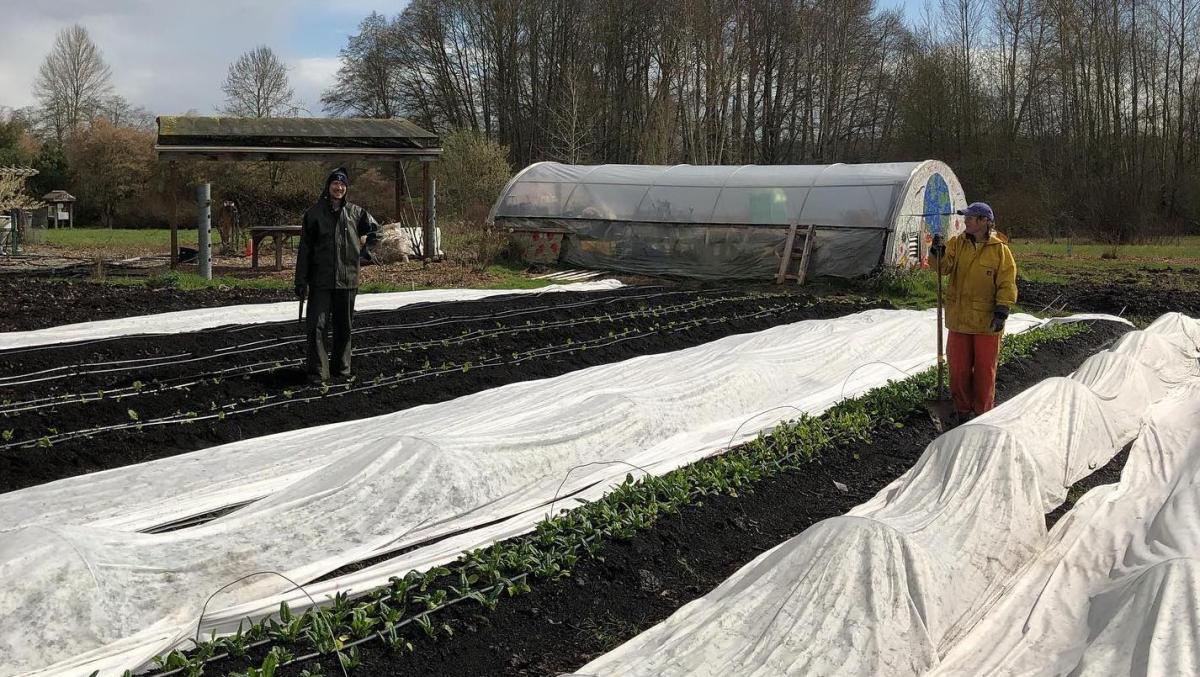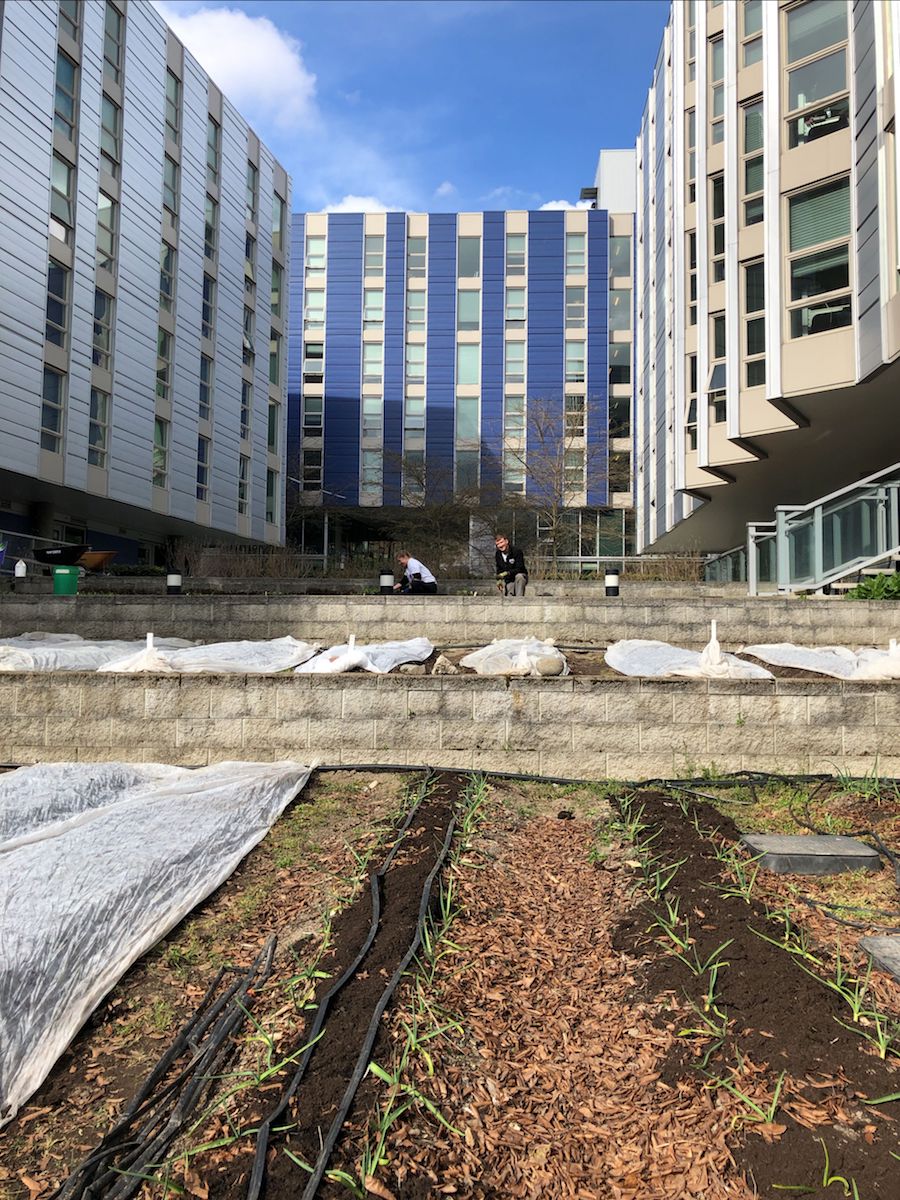
Guest post by UW Farm manager Perry Acworth
Wearing calf-high rubber boots, knit hats, gloves and full foul weather gear - overalls and hooded jackets - two farmers, keeping 6 feet apart if not more, commence transplanting hardened-off, 2-inch high multi-colored Swiss chard. Rain, and then hail, falls the entire day from gray, swiftly moving, cloudy skies. Two times the sun managed to come out, offering a brief break in the downpour.
The farm located at the Center for Urban Horticulture (CUH) is one of three growing sites for the UW Farm. The day began with "bed prep," creating planting areas, or beds, that are 30 inches wide and anywhere from 12 to 70 feet in length. The work begins with hauling wheelbarrows full of dark brown, chunky UW-made leaf and coffee ground mulch - full of earthworms and other invertebrates - from one end of the farm to the other.
After shaping the bed with the mulch, a 1-inch layer of fine-grained organic compost that was delivered by Cedar Grove is shoveled on top. It's steaming in the cool air, the result of millions of anaerobic and aerobic bacteria living in the mix. The compost material will serve to "inoculate" the soil, populating it with microscopic organisms that can break down those leaves and coffee grounds and the underlying soil.
A dark, ruddy-colored powder is the final amendment added to the planting bed. Scoop by scoop, using a re-purposed yogurt container, one farmer dusts the top of the long beds (difficult to do in the wind) before it is scratched into the surface with a long-handled cultivating fork.
The blood meal comes from ... well, dried blood. It is currently the preferred non-synthetic source of nitrogen fertilizer for the CUH site to deter rabbits, an urban (and rural) "pest." Because they are herbivores, not carnivores, rabbits are not too fond of munching on plants growing in by-products of the meat industry. Temporarily this may help ensure that the little Swiss chard plants will not be many bunnies' breakfast.
The work continues with the thrusting of a wooden dibble in the now soaking wet amended soil. The farmers take turns making holes and lowering the trays of young starts into a wheelbarrow filled with an opaque, odoriferous, water and fish fertilizer mix. Another by-product, this time from the fish industry. Each plant is dosed with this super food before being pushing into its 1-inch by 3-inch hole. By 5 p.m. 600 seedlings and more than 550 bed feet are planted, all by hand. The heavy precipitation over the last couple days and into this week means these plants will have a good start. Tomorrow is the same - lettuce is next and the farm site is on west campus at Mercer Court.
The two farmers pictured above are myself and Adam Houston, now the lone workers at the UW Farm. New "restricted operations" protocols were implemented to help reduce exposure to COVID-19 on the UW campus. Historically, during the spring quarter, the UW Farm would conduct field trips for over 300 students, hold labs for a couple of courses, instruct six dozen service learners completing farm-related assignments via the Carlson Center, work with interns and capstone students, and co-manage indigenous crops with wǝɫǝbʔaltxʷ Intellectual House members. Now Adam and I will try to help faculty create a "virtual farm" by figuring out how to create videos on-line while maintaining production. Produce will continue to be grown and sales will continue, just with fewer individuals doing the work.
 The lack of any student population or volunteers will be a test for the UW Farm. Can we carry out a production plan seamlessly without all the academic responsibilities? Can we grow food for our customers more easily without all the programs that utilize the Farm? Will we earn enough revenue as in previous years without all the volunteers? Or is the farm dependent on student labor provided via courses?
The lack of any student population or volunteers will be a test for the UW Farm. Can we carry out a production plan seamlessly without all the academic responsibilities? Can we grow food for our customers more easily without all the programs that utilize the Farm? Will we earn enough revenue as in previous years without all the volunteers? Or is the farm dependent on student labor provided via courses?
This is going to be a challenge mostly because we do almost everything by hand and are not mechanized. In addition, our sites are not efficient. They are designed for hosting large groups of people, not streamlined production (we are moving everything at Mercer Court in five-gallon buckets due to stairs-only access).
In the end we will learn a great deal about the UW Farm as a program and perhaps gain insight that we could not know if we were not in these challenging times. We may hold our annual plant sale on-line and, who knows, it may be hugely successful? At this writing, we are approved to maintain the Farm facility, which includes growing food. The UW Farm also has a history of delivering our CSA and produce to dining services and the UW Food Pantry with minimal or no-contact. We will research possibilities in this area in the upcoming months.
In closing, I can say that the two farmers maintaining the "living laboratory" that results in nearly 10,000 pounds of produce each year sold and donated to the community, are missing you all - our community. If you want to reach out and help the UW Farm weather the pandemic, please show your support and purchase a CSA share. We have three sessions - Summer, Peak and Fall. Sign up on-line, and the first box will come June 10th. Once we receive payment your share will be reserved. Take care, keep washing those hands, and lettuce grow your veggies for you!